The Toronto Maple Leafs are set to have a busy summer, but while most of the focus is on how they’re going to bolster their blue line, there are definitely other areas that could use improvement.
One of those key areas is the fourth-line centre role, which was manned primarily by Frederik Gauthier this past season. If the Maple Leafs want to get creative by improving the fringes of their roster, they should consider signing free agent Jason Spezza.
Gauthier and the Maple Leafs’ Fourth Line
It almost goes without saying that Gauthier is not a great fit for a team with Stanley Cup aspirations. Despite his 6-foot-5 frame and defensive utility, the Quebec-native was underwhelming this season, posting three goals and 14 points in 70 regular season games while being held off the scoresheet in seven playoff games. He finished dead-last in possession amongst Toronto forwards at 45.82 percent, and bottom-three in other key stats like scoring chances and high-danger chances for.

The issue with Gauthier is not his even-strength defence, as he was actually above average in that regard. Despite starting nearly 73 percent of his shifts in the defensive zone, Gauthier managed to limit scoring chances against when he was on the ice.
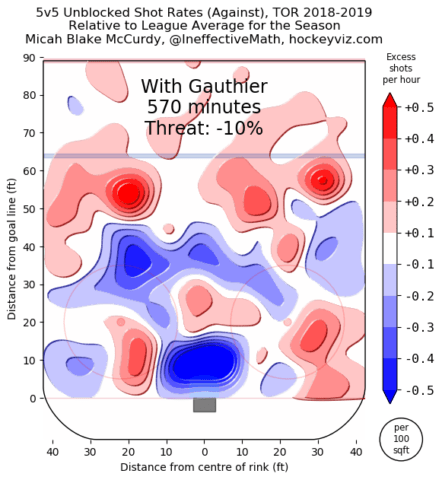
Where Gauthier falters at even-strength is his ability to generate offence, both for himself and linemates. Shots, scoring chances, and goals really suffer when the 24-year-old is on the ice.
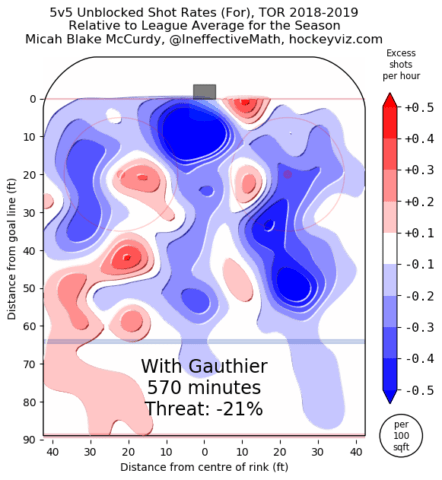
And despite Gauthier’s reputation as a defensively responsible centreman, he was hardly used on the penalty kill this season. During the few times he was used, the Maple Leafs were shelled.
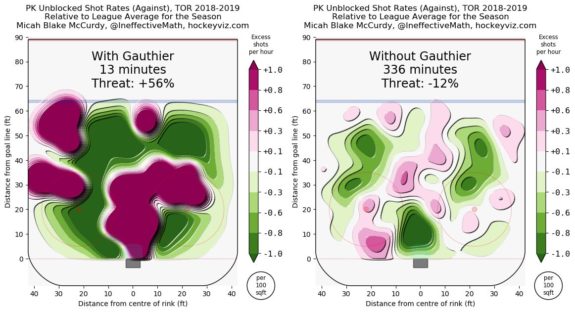
All things considered, the fourth-line centre role was a serious point of weakness for the Maple Leafs this season. If you subscribe to the notion that the fourth line should be occupied by defensive stalwarts and PK specialists, Gauthier doesn’t particularly fit that mold either. It should be an area that general manager Kyle Dubas at least looks into improving.
Enter Spezza.
Spezza Shone for Stars on the Power Play
Turning 36 this June, Spezza is no longer the 90-point player he once was for the Ottawa Senators in the mid-2000s. But the former second-overall pick still has plenty to offer, especially if used efficiently.
Spezza joined the Dallas Stars in 2014-15, posting over 50 points in each of his first three seasons with the team. He’s trailed off in his last two seasons, tallying just 26 and 27 points in 2017-18 and 2018-19, respectively. Where Spezza has continued to excel, though, is on the power play, and that’s exactly where the Maple Leafs could use his skills.

Of his 27 points this season, 12 were scored on the power play, placing him third on the team in power play production. Spezza’s 4.3 points-per-hour on the power play ranked third on the Stars (minimum 20 minutes played), and that mark was better than all but three Maple Leafs. Perhaps most impressive was his playmaking ability: Spezza produced 2.87 primary assists-per-hour, topping Mitch Marner’s mark of 2.83.
Spezza usually positions himself on the same half-wall that Marner does on the Maple Leafs’ power play. And he makes some similar plays as well.
In this first clip we see Spezza utilize the half-wall slap-pass that Marner has become famous for. Although his shot isn’t deflected by a teammate, the rebound falls directly to Miro Heiskanen, who one-times it past John Gibson. It’s a simple play, but it works for Marner, and is clearly a go-to move for Spezza too.
This second clip highlights Spezza’s skill and hockey IQ. He begins the play by carrying the puck up the ice, gaining the blue line, and dropping it off to Joel L’Esperance on his right. L’Esperance gives it back to Spezza and he makes a perfect no-look backhand pass across the ice to Esa Lindell, who rips it past Pekka Rinne. If Spezza were a few inches shorter and wearing #16, you might actually mistake him for Marner on that play.
These are the kinds of magical moments that Spezza can still produce on the power play, and for a Toronto team that struggled to score with the man-advantage down the stretch, he would be a useful addition.
Spezza Does the Little Things Well
Spezza frankly did not have the best 2018-19 season at even strength. He was above average in terms of possession but suffered in terms of on-ice goals.

The discrepancy between his expected on-ice goals and actual on-ice goals speaks to the fact that Spezza was unlucky to be outscored so badly, and that’s supported by his PDO of 97.2 (second-worst amongst Dallas forwards with at least 20 games played). But for his lack of results at even-strength this season, he is still a useful player who can drive play.
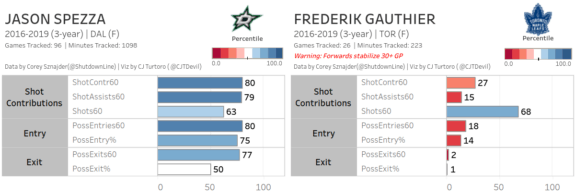
This chart tracks microstats, which are those subtle plays that often go unnoticed. Clean zone exits and entries, for example, don’t always show up on the scoresheet, but they help the team maintain possession of the puck and that usually leads to more goals. Over the last three seasons, Spezza has been well above average in shot contributions, zone entries, and zone exits. Gauthier, in comparison, shows poorly in six of seven categories, which matches up with all of our other data. The Maple Leafs struggle to control the puck when Gauthier is on the ice, and that’s obviously not the best way to win hockey games.
How Would the Maple Leafs Use Spezza?
Replacing Gauthier with Spezza would allow the Maple Leafs to bring a more skillful, modern look to their fourth line. With puck possession being more valuable than ever, a talented player like Spezza would be a noticeable upgrade. But how exactly would the Maple Leafs utilize him?
Spezza was deployed as a fourth liner in Dallas this season, so it’s not like he would be demoted in Toronto. He averaged 13:16 of ice time, including 11:02 at even-strength. He was used at both centre and right wing, but performed very well in the circle, winning 58.2 percent of draws. He’s not a defensive specialist by any means, but Spezza could certainly be trusted to win key faceoffs.
As alluded to, the real benefit to signing Spezza would be his power play production. It remains to be seen how newly hired assistant coach Paul McFarland will run the power play, but it’s fair to assume that Marner will be the primary half-wall distributor on the first unit. That first unit was generally effective while the second line saw a significant drop-off and could benefit from another gifted playmaker like Spezza.
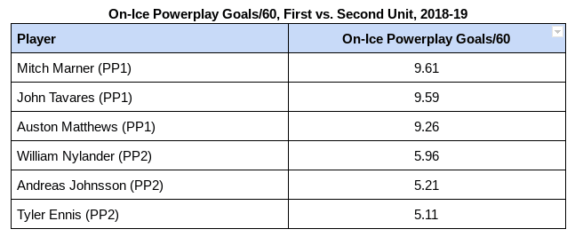
Depending on how the Maple Leafs configure their power play lines, Spezza could be used as either a primary or secondary distributor on the second unit. Nylander was generally deployed as the right half-wall playmaker on the second unit, but with the addition of Spezza, the Maple Leafs would now have two viable options as quarterbacks. Nylander could be moved to the left side as a one-timer threat, and Spezza would work his magic from the right wall. There’s even reason to argue that Spezza could play on the first unit given his performance this past season.
Can Spezza Fit Under the Cap?
The next logical question is whether the Maple Leafs can even afford Spezza. Most of the team’s cap space will be chewed up with contracts owed to restricted free agents Marner, Kasperi Kapanen, and Andreas Johnsson. But with the recent news that both Nikita Zaitsev and Patrick Marleau have requested trades, the Maple Leafs will have more wiggle room than previously thought.
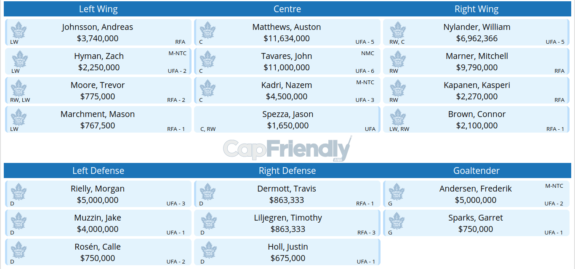
Factoring in the trades of Zaitsev and Marleau, the Maple Leafs will have plenty of space under the league’s projected $83-million salary cap. If we use Evolving Hockey’s contract projections, they can sign all of their RFAs, plus Spezza, and still have nearly $6.5 million to spend on one or two defencemen to upgrade the blue line.
Toronto Makes Sense for Spezza
Being a Toronto native and still in search of his first Stanley Cup, Spezza to the Maple Leafs makes sense in every way. He’s affordable and skilled, and the idea of a scoring fourth line matches up with Dubas’ progressive approach. He’s also a big body at 6-foot-3 with 70 points in 80 career playoff games – things that coach Mike Babcock would surely value.
The Maple Leafs are a Cup contending team, and when you reach that level, you need to maximize every part of your lineup. Gauthier may have only played eight minutes a night, but those eight minutes were generally spent chipping pucks out rather than making plays and scoring goals. Those extra few goals that Spezza creates would add up, and they might make all the difference in gaining home-ice advantage, and potentially helping the Maple Leafs win their first playoff series since 2004.
Player stats from naturalstattrick.com and hockey-reference.com